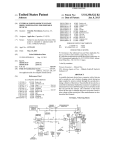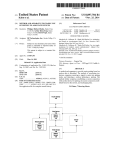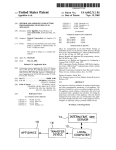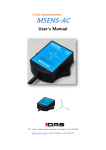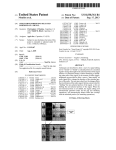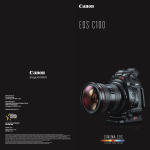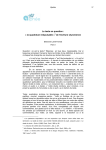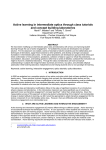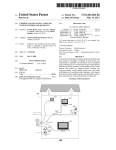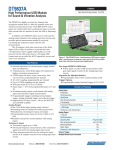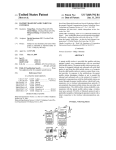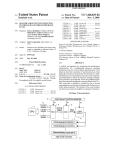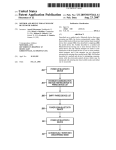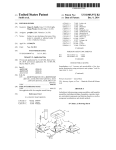Download Method and apparatus to enable pairing of devices
Transcript
US007907901B1 (12) United States Patent (10) Patent N0.: (45) Date of Patent: Kahn et al. (54) METHOD AND APPARATUS TO ENABLE Mayrhofer, R., Gellersen, H., “Shake Well Before Use: Authentica tion Based on Accelerometer Data”, In: Proc. Pervasive 2007, (75) Inventors: Philippe Kahn, Aptos, CA (US); Springer-Verlag, May 2007, pp. 144-161. Mayrhofer, R., Gellersen, H., “Shake Well Before Use: two imple mentations for implicit context authentication”, Adjunct Proc. Ubicomp 2007, Sep. 2007, pp. 72-75. Arthur Kinsolving, Santa Cruz, CA (US); David Vogel, Santa Cruz, CA (US) (73) Assignee: DP Technologies, Inc., Scotts Valley, CA Simonite, Tom, “synchronised shaking connects gadgets securely”, (Us) Notice: Mar. 15, 2011 OTHER PUBLICATIONS PAIRING OF DEVICES (*) US 7,907,901 B1 NeWScientist.com news service, http://WWW.neWscientist.com/ar ticle/dnl29l2, Nov. 13, 2007, 2 pages. Subject to any disclaimer, the term of this patent is extended or adjusted under 35 * cited by examiner U.S.C. 154(b) by 755 days. (21) App1.No.: 11/855,133 Primary Examiner * Eugene Yun (22) Filed: Zafman, LLP; Judith A. SZepesi (51) (52) (58) (74) Attorney, Agent, orFirm * Blakely, Sokoloff, Taylor & Sep. 13, 2007 Int. Cl. H04B 7/00 H04B 5/00 (57) (2006.01) (2006.01) A method and apparatus to provide easier pairing based on motion data is described. The method of pairing tWo devices U.S. Cl. ..................... .. 455/41.2; 455/41.1; 455/502 Field of Classi?cation Search ............... .. 455/41.2, comprises receiving a signal to enter into pairing mode, and 455/41.3, 41.1, 425, 502, 13.2 See application ?le for complete search history. (56) ABSTRACT detecting a motion indicating a pairing. The method further comprises establishing a secure connection With another device forpairing, the secure connection establishedbased on References Cited the motion, and exchanging data for pairing. U.S. PATENT DOCUMENTS 2007/0213045 A1 * 9/2007 11 Claims, 7 Drawing Sheets Hermansson et al. ...... .. 455/425 Fourth Device 140 1 7 ' First Device 110 Motion Sensor 11s 1 Second Device 120 Motion 7 Sensor 125 Third Device 130 Motion Sensor 135 Sewer 150 US. Patent Mar. 15, 2011 Sheet 1 0f 7 US 7,907,901 B1 Fourth Device 140 First Device 1 10 Motion 7 Second Device 120 Motion Sensor 125 Server 150 y Third Device 130 Motion Sensor 135 Fig. 1 l Sensor 1 15 US. Patent Mar. 15, 2011 US 7,907,901 B1 Sheet 2 0f 7 Pairing Logic 210 Motion Sensor 1 15 User Interface 220 Motion Database 235 Motion Identifier 230 Discovery Logic 280 i Target Device Identi?cation Logic 240 Device Patterns 245 i Secure Connection Key Generation Logic Logic 250 255 1 Data Exchange Logic 260 Pair Data 270 Connection Logic 280 Fig. 2 US. Patent Mar. 15, 2011 Sheet 3 017 / Start \ K 310 ) Initiate pairing 320 i Detect motions for pairing 330 i Establish secure connection 340 i Exchange data for pairing 350 Q End 360 Fig. 3 /' US 7,907,901 B1 US. Patent Mar. 15, 2011 Sheet 4 017 US 7,907,901 B1 Start 41 0 Recelve command to place device in pairing mode 420 Identify motions initiating pairing 430 1 Generate key to create secure connection 440 1 Device attempts connection with identified pair 445 can established? 450 Inform user of failed connection attempt 460 Yes Exchange data for pairing & close connection 470 1 End 480 Fig. 4 US. Patent Mar. 15,2011 Sheet 5 017 US 7,907,901 B1 Start 510 Detect motions initiating pairing 520 Send out discovery message 530 No \ \ Any response? 540 Time N0 \ out? 545 Yes I \/ YesT Compare motions detected 555 /Do motions match?\ No \\ 560 /— \\ Create secure connection 570 i Exchange data for Pairing & close connection 58° Fig. 5 US. Patent Mar. 15, 2011 Sheet 6 017 US 7,907,901 B1 Detect series of motions 620 i Identify device indicated by motions 630 i Send out connection request to identified device 640 7 Create key for secure channel based on motions 650 Connection made? 660 Secure connection using key 680 L End 690 Fig. 6 US. Patent Mar. 15,2011 77 o Display Sheet 7 017 US 7,907,901 B1 765 A 700 <—> 710 Processing 775 Unit 750 Mem°ry A|phanum_eric Input Devlce v 780 715 Bus k Cursor Control <—> 725 790 Commun_ications Devlce Fig. 7 ' 720 S322‘; Non-volatile Device storage > US 7,907,901 B1 1 2 METHOD AND APPARATUS TO ENABLE PAIRING OF DEVICES FIG. 3 is an overview ?owchart of one embodiment of pairing. FIG. 4 is a ?owchart of one embodiment of pairing. FIG. 5 is a ?owchart of one embodiment of associating the two devices. FIG. 6 is a ?owchart of an alternative embodiment of FIELD OF THE INVENTION The present invention relates to pairing, and more particu larly to pairing at least two mobile devices to each other. associating the two devices. FIG. 7 is a block diagram of one embodiment of a computer system which may be used with the present invention. BACKGROUND DETAILED DESCRIPTION Pairing describes associating devices with each other. For example, a multi-device remote control may need to be paired with the associated television, or a Bluetooth headset may be paired with the mobile phone that the user would like to use The method and apparatus described is for enabling pairing of two or more devices. The process, in one embodiment, includes putting both devices in pairing mode, then perform with it. Generally, in the prior art pairing the devices was a long and involved process. For example, a typical pairing of a Bluetooth headset with a phone may include the following ing a motion such as shaking the devices holding them in the The headset: same hand. The movement pattern, in one embodiment, is used both to identify which devices one intends to pair and then generate the key that will create the secure connection. In an alternate embodiment, a certain motion automatically launches the pairing process. The process then looks for Put the headset into “Discoverable” mode (usually by hold nearby devices and attempts to pair with them, only complet ing a button or sequence of buttons) so that the phone can ?nd it. Refer to your headset’s user manual to ?nd out the PIN code. ing the pairing if the exact motion pattern of that device’s motion and the date/time stamp of the motion also match. In steps: 20 25 The phone: by the accelerometer in each device are of the same magni tude. In contrast, if the devices were simply held separately, From the home screen, press and hold the Home key. Select the “Communications Manager” (second option) Press the “Settings” menu and choose “Bluetooth Settings” Choose Menu>Devices Choose Menu>New After a few seconds, the name of your headset will be 30 and similar motions were made, there would be a differential 35 not only because humans cannot reproduce the identical motions, but also because of mass differentials between the devices. FIG. 1 is a network diagram of the devices. A ?rst device 110 is designed to be paired with a second device 120. Both 40 devices, in one embodiment, include a motion sensor 115, 125. The user then performs a preset motion with both devices in one hand. This ensures that both devices receive exactly the same motion data. This motion data is used to pair the two devices. This process is described in more detail below. displayed along with any other Bluetooth devices in range. Highlight the name of the headset that you wish to pair and press the ‘Next’ key. Enter the PIN code (found in the headset manual) to bond the two devices together. Press “Next” to pass by the renaming of the headset. On the services screen, ensure that the “Wireless Stereo” An alternative pairing may be between the ?rst device 110 and the third device 130. The third device 130, in one embodi ment, also includes a motion sensor 135. However, in this service is ticked then press “Done” Press “Done” on the next screen, then “Done” on the Next, then “Done” on the next. Press Exit to leave the Communication Manager As can be seen, this process is rather involved and requires a lot of steps, including looking up codes in a handbook and one embodiment, this happens in the background transpar ently to the user. By holding the two devices together, they become effectively one body, and the accelerations measured example, the third device 130 does not have the processing 45 capability necessary to provide motion analysis, provide device identi?cation, and/or provide an encryption key for a secure connection. Therefore, the third device 130 relies on a server 150 to provide at least some processing and/or memory working through multiple menus. SUMMARY OF THE INVENTION 50 A method and apparatus to provide easier pairing based on motion data is described. The method of pairing two devices for the connection. In one embodiment, both the ?rst device 110 and third device 130 are coupled to the server 150. In another embodiment, only one of the devices is coupled to the server 150, and the other device need not be aware of the comprises receiving a signal to enter into pairing mode, and server connection. When a server is involved in the process, detecting a motion indicating a pairing. The method further comprises establishing a secure connection with another any portion of the processing may take place on the server. An alternative pairing may be between the ?rst device 110 55 and a fourth device 140, which does not have a motion sensor. The fourth device 140 may be a conventional device which device for pairing, the secure connection established based on the motion, and exchanging data for pairing. does not include an accelerometer or similar motion sensor. BRIEF DESCRIPTION OF THE DRAWINGS 60 phone including an accelerometer. The pairing of these devices may be accomplished using the accelerometer to reduce the complexity and navigation requirements, as will The present invention is illustrated by way of example, and not by way of limitation, in the ?gures of the accompanying drawings and in which like reference numerals refer to similar elements and in which: FIG. 1 is a network diagram of the devices. FIG. 2 is a block diagram of one embodiment of the pairing mechanism. For example, the fourth device 140 may be a conventional Bluetooth headset, while the ?rst device 110 is a mobile 65 be described below. FIG. 2 is a block diagram of one embodiment of the pairing logic. In one embodiment, the pairing logic resides on one of the mobile devices. In one embodiment, only one of the US 7,907,901 B1 3 4 devices has the pairing logic. In one embodiment, the pairing At block 340, a secure connection is established. The secure connection is established based on the motions detected. In one embodiment, the secure connection is an logic 210 may be split betWeen the handheld device and a remote device, such as a server. In another embodiment, both devices have a pairing logic. In one embodiment, one or both encrypted connection. At block 350, data is exchanged betWeen the devices for of the devices may include a subset of the pairing logic elements described. The motion sensor 115 provides data to motion identi?er pairing. Once devices are paired, their connection can be automatically established in the future. 230. Motion identi?er 230 identi?es the motion. In one embodiment, the motion identi?er uses a database of motions The process ends at block 360. FIG. 4 is a ?owchart of one embodiment of pairing. The process starts at block 410. At block 420, a command to place 235 to identify the meaning of each motion. In one embodi ment, the motions may initiate pairing. In one embodiment, the user may initiate pairing through user interface 220. User interface 220 may also be used to de?ne the motions used for the device into pairing mode is received. In one embodiment, this command may be initiated through a menu selection, through a motion, or through other means. In one embodi pairing. In another embodiment, the motions, stored in ment, When the device is placed in pairing mode, the system motion database 235, are pre-de?ned. In one embodiment, When the motion for pairing is identi ?ed by motion identi?er 230, or initiated by user interface 220, the subsequent motions are passed to target device iden ti?cation logic 240. In one embodiment, the motion identi?er 230 identi?es the motion components, and passes these iden ti?ed motion components to target device identi?cation logic 240. For example, a motion component may be a “rapid indicates to the user to take both devices, hold them together, and perform a pairing motion. In one embodiment, the device may provide a list of potential pairing motions, based on the horizontal shake” or a “clockWise circle,” etc. The target device identi?cation logic 240 uses these motion compo 20 With a Bluetooth headset. For another example, a double shake up and doWn may indicate pairing With a particular 25 Secure connection logic 250 then establishes a secure con 30 1000 integer counts. During the initial steady state, in one embodiment the dominant vector affected by Earth’s gravi to establish the secure connection. Since the tWo devices are moved together, they have performed the identical motions, 35 fore, the motion data can be used to ensure that the correct devices are paired. In one embodiment, relative motion data is used, instead of absolute motion data. This ensures that even if there are calibration differences betWeen the accelerom eters in the tWo devices, the same key is generated. In one embodiment, the accelerometer data is smoothed, ms. In one embodiment, each of the axes Will be scaled to have a normaliZed motion of l-G acceleration equivalent to generate a key, by key generation logic 255. This key is used and thus captured substantially identical motion data. There sensor. In one embodiment, motion data is ?ltered on all three axes using a loW-pass ?lter. In one embodiment, the loW pass ?lter is con?gured to have a frequency cutoff at 4 HZ. The ?lter removes transient noise and alloWs the detection of hand movement that exhibits a change of direction greater than 250 nents, and data from the device patterns library 245, to iden tify Which devices should be paired. nection betWeen the device and the identi?ed target device. In one embodiment, the motions (i.e. accelerations) are used to identity of the devices to be paired. At block 43 0, the motions initiating pairing are received. In one embodiment, the motions identify the device to be paired. For example, a triple shake of the device may indicate pairing tational ?eld Will be used to determine the accelerometer orientation on both devices. In one embodiment, this process is performed for both devices. At block 440, a key is generated to create a secure connec 40 tion. In one embodiment, the key is generated based on the exact motions performed by the user, to initiate pairing. In one embodiment, the key is based on differential motion (i.e. the relationship betWeen various measurements, rather than exact ?ltered, and/or normaliZed prior to performing the key gen measurements). This ensures that even if the tWo devices have eration. This ensures that the tWo devices’ data match if they experienced the same motions. In one embodiment, a clock differential betWeen the tWo devices is identi?ed, so that an “absolute” clock time may be used for comparison purposes. For example, the system may calculate that one of the devices is 3 seconds ahead of the other device, and is 0.02 seconds faster (per second skeW). This may be used to ensure that When motions are compared, the calculated “absolute” time When they occur is identical on both devices. not been cross-calibrated, the proper key is generated. In one embodiment, the measurement of the accelerometer orienta 45 tion is used to perform an axis translation on both devices. 50 Along With the axis normalization and axis translation, the directional acceleration and amplitude measurements Will be equivalent on both devices. In one embodiment, using direc tion, acceleration amplitude and time, a coded numeric sequence Will be computed and used as the key for both Data exchange logic 260 exchanges data for pairing With the paired device. This data is obtained from Pair data 270, and any relevant data to be used for future connections is stored. In one embodiment, the future connection data is also 55 stored in pair data 270. In subsequent uses of the device, connection logic 280 utiliZes the stored data from pair data 270, to establish a connection With the other device. In one embodiment, this occurs automatically When the device is subsequently turned on. The use of paired devices is knoWn in the art. nection attempt. 60 FIG. 3 is an overvieW ?owchart of one embodiment of pairing. The pairing is initiated, at block 320. As noted above, the pairing may be initialiZed by a user action. At block 330, the pairing motions are detected. In one embodiment, if the pairing is initiated by motion, blocks 320 and 330 may refer to the same motions. devices. At block 445, the device attempts to connect With the identi?ed device to be paired. In one embodiment, both devices attempt to establish a connection. In another embodi ment, one device is the “host” device Which has the softWare to establish such a connection, While the other device is the “client” device Which is more passive, and receives the con At block 450, the process determines Whether a secure connection can be established. If not, at block 460, the user is informed of the failed connection attempt. In one embodi ment, the connection attempts are retried for a number of tries, or a preset amount of time, before this occurs. The process then ends, at block 480. 65 If a secure connection can be established, at block 470, data for pairing is exchanged. The secure connection is then closed, in one embodiment. In another embodiment, a pairing US 7,907,901 B1 5 6 channel is opened, based on the pairing data, so that the devices are immediately paired for use. The process then ends, at block 480. i.e. Bluetooth headset. In another embodiment, the protocol used by the device is identi?ed, i.e. Bluetooth device. In another embodiment, the device manufacturer and type is identi?ed, i.e. Jabra Bluetooth headset. In yet another embodiment, the precise device is identi?ed, i.e. the Jabra FIG. 5 is a ?owchart of one embodiment of associating the two devices. The process starts at block 510. At block 520, pairing motions are detected. In one embodi Freespeak headset. ment, the user may initiate pairing mode prior to performing At block 640, a connection request is sent out to the iden ti?ed device. In one embodiment, the request is as targeted as pairing motions. In another embodiment, the pairing motions may automatically initiate pairing mode. possible. At block 530, a discovery message is sent out. The discov ery message, in one embodiment, is sent out in the format indicated by the pairing motions. For example, for a Blue tooth device, the discovery protocol may be to send out a “wake-up” message paired with a “trigger connection mes sage.” Each protocol and/or device may have a different dis At block 650, a secure channel is created. In one embodi ment, the secure channel is created by creating a unique key 5 covery message. At block 540, the process determines whether there was any response. If not, the process continues to block 545. At generating the key may be used. block 545, the process determines whether the pairing has timed out. If not, the process returns to block 530, to send out a new discovery message. In one embodiment, the pairing process is maintained for a preset period of time, or a preset based on the motions performed by the user. The motion data may be converted into a series of numbers, i.e. each motion segment represented by a number. In one embodiment, a look-up table may be used for this conversion. In one embodi ment, the series of numbers may be used to generate the key, through a one way hash function. Alternative methods of 20 At block 660, the process determines whether a successful connection was made. If not, the process determines if the attempt has timed out. If not, the process continues to try for a connection. Otherwise, the process ends at block 690. number of discovery messages. For example, the system may If a connection is made, it is secured using the key, at block attempt pairing for 1 minute, with discovery messages being 680. The data exchange as described above occurs at that re-sent every 10 seconds. If the system times out, the process ends at block 550. If a response is received, at block 540, the process contin 25 point. The process then ends. 30 be used with the present invention. It will be apparent to those of ordinary skill in the art, however that other alternative systems of various system architectures may also be used. The data processing system illustrated in FIG. 7 includes a FIG. 7 is one embodiment of a computer system that may ues to block 555. At block 555, the process compares the detected motions to establish whether the devices were moved together for pair ing. In one embodiment, comparing the detected motions is a three step process. First, in one embodiment, the systems perform a clock differential correction. In one embodiment, the clock differ ential correction involves using the time stamps on handshake bus or other internal communication means 715 for commu nicating information, and a processor 710 coupled to the bus 715 for processing information. The system further com prises a random access memory (RAM) or other volatile 35 messages, to determine clock differential between the devices. The clock differential may include a per/minute dif processor 710. Main memory 750 also may be used for stor ing temporary variables or other intermediate information ferential as well as a base differential. For example, clockA may be 3 seconds ahead, while clock B loses 0.1 second per minute. Once the clock differential is determined, the system during execution of instructions by processor 710. The sys 40 tem also comprises a read only memory (ROM) and/ or static storage device 720 coupled to bus 715 for storing static infor mation and instructions for processor 710, and a data storage device 725 such as a magnetic disk or optical disk and its 45 to bus 715 for storing information and instructions. The system may further be coupled to a display device 770, such as a cathode ray tube (CRT) or a liquid crystal display has an absolute time available to use for the comparison. Second, the system in one embodiment accounts for dif ferent relative positions between the objects being paired. Since the user can hold the devices together in any con?gu ration, the detected motions would be along different axes depending on relative positions. This also compensates for different accelerometer locations and orientations within the devices. In one embodiment, a ?rst motion pattern is used to orient the relative accelerometers. In one embodiment, for each motion pattern, the ?rst motion is a spike or other notice storage device 750 (referred to as memory), coupled to bus 715 for storing information and instructions to be executed by corresponding disk drive. Data storage device 725 is coupled (LCD) coupled to bus 715 through bus 765 for displaying information to a computer user. An alphanumeric input able motion pattern. device 775, including alphanumeric and other keys, may also be coupled to bus 715 through bus 765 for communicating Third, the system compares motions or accelerations at absolute times. In one embodiment, the motion data is ?ltered information and command selections to processor 710. An additional user input device is cursor control device 780, such 50 and smoothed, prior to comparison. At block 560, the process determines whether the motions match. If they do not match, the process returns to block 545, as a mouse, a trackball, stylus, or cursor direction keys 55 to determine whether the process should time out or resend the discovery message. If the motions match, at block 570 the secure connection is created, and data is exchanged for the pairing, at block 580. 60 FIG. 6 is a ?owchart of an alternative embodiment of commercially available networking peripheral devices such associating the two devices. The process starts at block 610. At block 620, a series of motions is detected. At block 630, the series of motions is identi?ed as a series of motions to initiate pairing, with device identi?cation. At block 630, the system further identi?es the device indicated by the motions. In one embodiment, the particular device type is identi?ed, coupled to bus 715 through bus 765 for communicating direc tion information and command selections to processor 710, and for controlling cursor movement on display device 770. Another device, which may optionally be coupled to com puter system 700, is a communication device 790 for access ing other nodes of a distributed system via a network. The communication device 790 may include any of a number of as those used for coupling to an Ethernet, token ring, Internet, 65 or wide area network. The communication device 790 may further be a null-modem connection, or any other mechanism that provides connectivity between the computer system 700 and the outside world. Note that any or all of the components US 7,907,901 B1 7 8 of this system illustrated in FIG. 7 and associated hardware may be used in various embodiments of the present invention. in the appended claims. The speci?cation and drawings are, It will be appreciated by those of ordinary skill in the art that any con?guration of the system may be used for various purposes according to the particular implementation. The control logic or software implementing the present invention restrictive sense. can be stored in main memory 750, mass storage device 725, or other storage medium locally or remotely accessible to processor 710. It will be apparent to those of ordinary skill in the art that the system, method, and process described herein can be implemented as software stored in main memory 750 or read only memory 720 and executed by processor 710. This con trol logic or software may also be resident on an article of accordingly, to be regarded in an illustrative rather than a What is claimed is: 1. A method of pairing two devices comprising: receiving a signal to enter into a pairing mode, the signal comprising a motion signature that is generated upon a user moving at least one of the two devices in a prede termined motion pattern that identi?es a type of device to pair with, wherein the signal automatically initiates the pairing mode; detecting a motion indicating a pairing; 15 manufacture comprising a computer readable medium having computer readable program code embodied therein and being readable by the mass storage device 725 and for causing the motion; and exchanging data for pairing. 2. The method of claim 1, wherein receiving a signal to processor 710 to operate in accordance with the methods and teachings herein. enter into pairing mode further comprises receiving indica 20 The present invention may also be embodied in a handheld or portable device containing a subset of the computer hard ware components described above. For example, the hand held device may be con?gured to contain only the bus 715, the processor 710, and memory 750 and/or 725. The handheld establishing a secure connection with another device for pairing, the secure connection established based on the tion through a user interface that a pairing is about to be initiated. 3. The method of claim 1, wherein the signal indicating a pairing further comprises a signal identifying a target device for pairing. 25 4. The method of claim 1, wherein the motion indicating a device may also be con?gured to include a set of buttons or pairing comprises any motion performed simultaneously input signaling components with which a user may select from a set of available options. The handheld device may also be con?gured to include an output apparatus such as a liquid with the two devices. crystal display (LCD) or display element matrix for display 5. The method of claim 1, wherein a key is generated based on the motion, the key used for the secure connection. 30 ing information to a user of the handheld device. Conven tional methods may be used to implement such a handheld user moving at least one of the two devices in a prede device. The implementation of the present invention for such a device would be apparent to one of ordinary skill in the art given the disclosure of the present invention as provided herein. The present invention may also be embodied in a special purpose appliance including a subset of the computer hard ware components described above. For example, the appli termined motion pattern that identi?es a type of device 35 perform a motion with the two devices together during the pairing process; and 40 nications mechanisms, such as a small touch-screen that per mits the user to communicate in a basic manner with the 45 50 identifying a target device based on the motion; performing a handshake with the device; synchronizing clocks of the two devices based on the hand shake data; and using the motion data and associated clock data to pair the two devices. 10. A method of pairing a ?rst device and a second device can be stored on any machine-readable medium locally or 55 comprising: receiving a signal to enter into a pairing mode, the signal comprising a motion signature that is generated upon a information in a form readable by a machine (eg a com puter). For example, a machine readable medium includes read-only memory (ROM), random access memory (RAM), user moving at least one of the ?rst device or the second magnetic disk storage media, optical storage media, ?ash memory devices, electrical, optical, acoustical or other forms establishing a secure connection for the pairing, the secure connection established based on the motion. 9. The method of claim 6, further comprising: tion. In some devices, communications with the user may be through a touch-based screen, or similar mechanism. remotely accessible to processor 710. A machine-readable medium includes any mechanism for storing or transmitting pairing the devices based on the motion. 7. The method of claim 6, further comprising: using an additional motion signature derived from the motion to identify the devices to be paired. 8. The method of claim 6, further comprising: a bus 715, and memory 750, and only rudimentary commu It will be appreciated by those of ordinary skill in the art that any con?guration of the system may be used for various purposes according to the particular implementation. The control logic or software implementing the present invention to pair with, wherein the signal automatically initiates the pairing mode; instructing a user to hold the two devices together and ance may include a processor 710, a data storage device 725, device. In general, the more special-purpose the device is, the fewer of the elements need be present for the device to func 6. A method of pairing two devices comprising: receiving a signal to enter into a pairing mode, the signal comprising a motion signature that is generated upon a 60 device in a predetermined motion pattern that identi?es a type of device to pair with, wherein the signal auto matically initiates the pairing mode; of propagated signals (e. g. carrier waves, infrared signals, digital signals, etc.). initiating the pairing mode in the ?rst device and the second In the foregoing speci?cation, the invention has been described with reference to speci?c exemplary embodiments thereof. It will, however, be evident that various modi?ca tions and changes may be made thereto without departing receiving simultaneous, identical motion information at the ?rst device and the second device, resulting from a from the broader spirit and scope of the invention as set forth device; 65 user moving the ?rst device and the second device together; US 7,907,901 B1 10 using the motion information to establish a secure connec tion betWeen the ?rst device and the second device; and exchanging data for pairing through the secure connection. 11. A method of pairing a ?rst device to a second device, the method comprising the ?rst device: receiving motion information indicating entry into pairing mode, the motion information comprising a motion sig nature that is generated upon a user moving the ?rst device in a predetermined motion pattern that identi?es a type of device to pair With, Wherein the motion infor mation automatically initiates the pairing mode; sending out a discovery signal to discover the second device; comparing the motion information With data from the sec ond device to identify the correct second device; setting up a secure connection betWeen the ?rst device and the second device; and exchanging data for pairing through the secure connection. * * * * *













